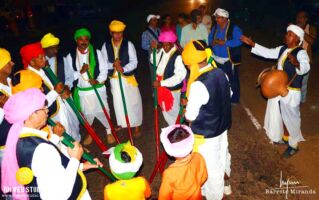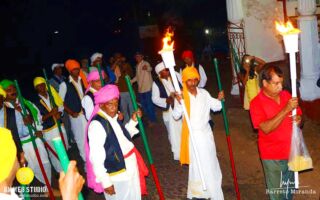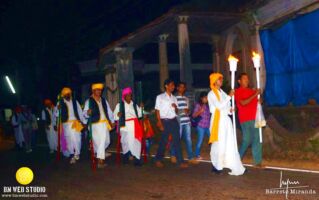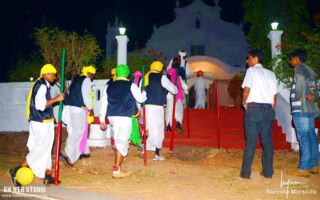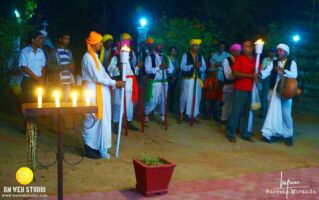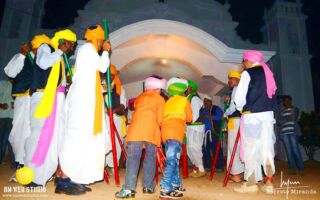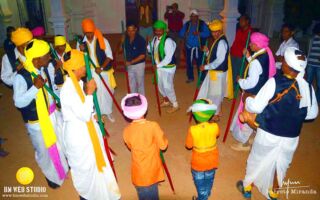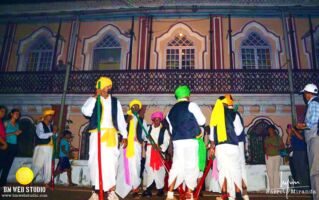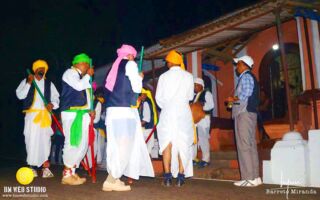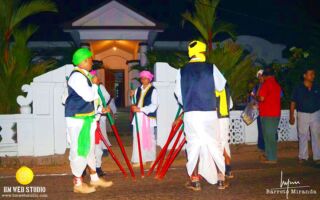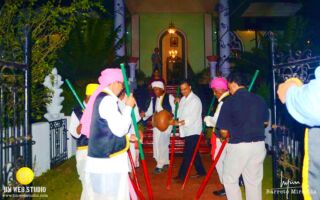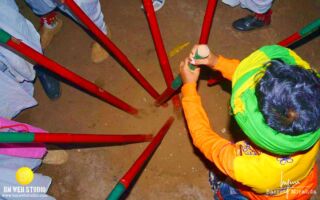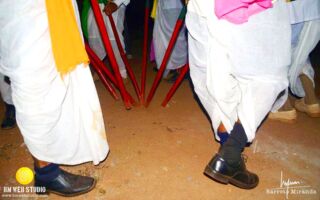Mussoll Dance at Cota, Chandor
At the historical village of Chandor in the Kshatriya (warrior) caste villager’s courtyard this Mussal (pounding mace) march – cum- dance is performed on the second day of Goan Carnival. The dance performed by men who carry ‘Mussal’ – a war weapon in medieval times, is performed with full Hindu martial even though the Kshatriyas of Chandor converted to Christianity long ago. The dance-cum-song is performed to celebrate the victory in the early 14th century of the Hindu King of Vijaynagar, Harihar, over the Cholas.
With a spring in step and pestle in hand
Place: Cota, Chandor
It’s the second day of Carnival. The serene village is already enveloped by the moonless night. An all-male group, all Catholics, decked in traditional attire – a dhoti, a jacket, a colourful turban, ghungroos (ankle bells) on the left foot- and carrying a musoll (pestle), starts gathering at the mandda khuris. The village suddenly comes alive with the clanging of the bells at the small chapel. After lighting candles and reciting a Christian prayer before the cross, the mussoll dance is performed by pounding pestles into the ground. The dance over, the performers then march in procession holding lit torches to the San Tiago chapel, where the sequence is repeated. From here, they march from house to house performing the mussoll dance or the mussllam khell to the accompaniment of percussion instruments as they sing the musoll song.
“It’s a ritual that has been kept alive by residents. The dance is performed by Chandor’s Chardo gaonkars (the descendents of the original founders of the village commune). It’s unique to Chandor. It used to be performed with much more zest and gusto during our younger days, but now that sort of enthusiasm is sadly lacking,” an elderly resident who had gathered to watch the dance, said.
The dance, with minor variations, is also performed at the neighbouring Cavorim ward, on the third day of the Carnival.
The ritual, however, begs a question: What has the mussoll dance, essentially rooted in Hindu tradition and character, anything to do with Carnival, a Western festival?
Octogenarian Zenaides Morenas, a researcher from Chandor, attempts to provide a perspective. “The most popular Goan Hindu festival is Shigmo which falls in the month of Phalguna of the Hindu calendar. The mussoll dance, which is essentially Hindu in character, came to be associated with Carnival as it precedes the Christian Lenten season and invariably falls in the month of Phalguna. The dance has persisted as a continuing cultural expression of Chandor’s Chardos since their conversion to Christianity,” Morenas told TOI.
Referring to the elaborate research work he has carried out on the mussoll dance, and which is contained in a book, “The Mussoll dance of Chandor,” authored by him, Morenas attempts to throw more light into the ritual that offers a peep into the rich history of Goa and its ancient capital, Chandrapur, as Chandor was once known.
“The mussllam khell is a ritual, and not a folk dance, aimed at driving away evil by invoking the gods. It’s a dance based on the story of the legendary prowess of the ancient Kshatriyas from whom the Christian Chardos of Chandor, as elsewhere in Goa, descend. The mussoll dance is performed near the village mandd (The mandda khuris, from where the dance begins, derives its name from the nearby ancient site of the Chandreshwar temple which now lies in ruins and where the village mandd once stood). It is an enactment of the Kshatriya story that must have been dramatically exhibited in the sabhamandap of the royal temple of Lord Chandrewshwar at Cota, whose ruins, to date, are a reminder of the splendor of the old city – a story that would have been dramatized with as many variations as the circumstances of the time permitted. Since the conversion of the Kshatriyas to Christianity, the dance has persisted as a continuing cultural expression of Chandor’s Chardos,” Morenas explains.
Meanwhile, at Cota, the strains of the mussoll song have begun to ascend in pitch as the crowd too swells to witness the pestle dance.
Article by Govind Kamat Maad (TOI)
Photos by Lynn Barreto Miranda / lynn.barretomiranda.com

Scan the code for directions.

website designed by bmwebstudio
goa / ph: 9822151419


